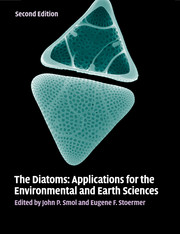Book contents
- Frontmatter
- Contents
- List of contributors
- Preface
- Part I Introduction
- Part II Diatoms as indicators of environmental change in flowing waters and lakes
- Part III Diatoms as indicators in Arctic, Antarctic, and alpine lacustrine environments
- Part IV Diatoms as indicators in marine and estuarine environments
- Part V Other applications
- 24 Diatoms of aerial habitats
- 25 Diatoms as indicators of environmental change in wetlands and peatlands
- 26 Tracking fish, seabirds, and wildlife population dynamics with diatoms and other limnological indicators
- 27 Diatoms and archeology
- 28 Diatoms in oil and gas exploration
- 29 Forensic science and diatoms
- 30 Toxic marine diatoms
- 31 Diatoms as markers of atmospheric transport
- 32 Diatoms as non-native species
- 33 Diatomite
- 34 Stable isotopes from diatom silica
- 35 Diatoms and nanotechnology: early history and imagined future as seen through patents
- Part VI Conclusions
- Glossary, acronyms, and abbreviations
- Index
- References
26 - Tracking fish, seabirds, and wildlife population dynamics with diatoms and other limnological indicators
from Part V - Other applications
Published online by Cambridge University Press: 05 June 2012
- Frontmatter
- Contents
- List of contributors
- Preface
- Part I Introduction
- Part II Diatoms as indicators of environmental change in flowing waters and lakes
- Part III Diatoms as indicators in Arctic, Antarctic, and alpine lacustrine environments
- Part IV Diatoms as indicators in marine and estuarine environments
- Part V Other applications
- 24 Diatoms of aerial habitats
- 25 Diatoms as indicators of environmental change in wetlands and peatlands
- 26 Tracking fish, seabirds, and wildlife population dynamics with diatoms and other limnological indicators
- 27 Diatoms and archeology
- 28 Diatoms in oil and gas exploration
- 29 Forensic science and diatoms
- 30 Toxic marine diatoms
- 31 Diatoms as markers of atmospheric transport
- 32 Diatoms as non-native species
- 33 Diatomite
- 34 Stable isotopes from diatom silica
- 35 Diatoms and nanotechnology: early history and imagined future as seen through patents
- Part VI Conclusions
- Glossary, acronyms, and abbreviations
- Index
- References
Summary
Introduction
The application of diatoms in paleoenvironmental studies has largely focused on tracking past changes in water chemistry (e.g. nutrients, salinity, pH) and habitat features (e.g. lake ice or macrophytes). When used in conjunction with other paleolimnological proxies, however, diatoms can be used to infer past changes in vertebrate populations or harvests such as fish, birds, and whales. This research is particularly insightful because the fossil record of these vertebrates is fragmented and sparsely distributed. Time series of inferred animal population dynamics also provide the much-needed long-term data required to develop sustainable management plans for these often ecologically sensitive and sometimes commercially harvested taxa (e.g. Selbie et al., 2007).
Many studies that are included in this review are focused on population dynamics of migratory animals. A common thread across these studies is that large densities of migratory animals can introduce substantial nutrient loads to lakes. If the animal population is, at any time, contributing the largest source of nutrients to a study lake, then fluctuations in nutrients can be correlated to the animal's population size. Given that diatom community composition is strongly influenced by nutrient status (see Hall and Smol, this volume), the diatoms are then indirect indicators of animal population dynamics. A second field of study included in this review is focused on changes in non-anadromous fish populations. There have been numerous studies showing that fish kills, fish introductions, or human manipulations of fish community structure can influence primary producers and/or water quality.
- Type
- Chapter
- Information
- The DiatomsApplications for the Environmental and Earth Sciences, pp. 497 - 513Publisher: Cambridge University PressPrint publication year: 2010



